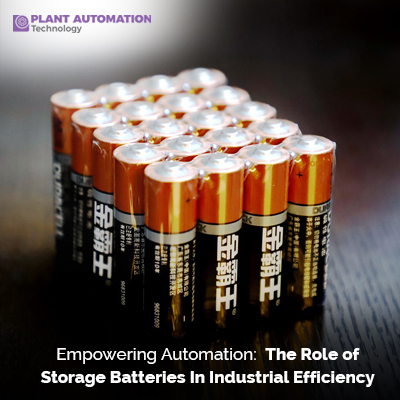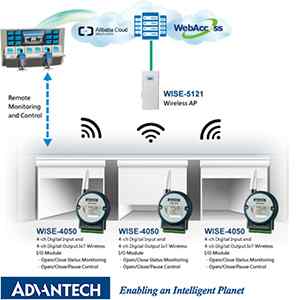Empowering Automation: The Role of Storage Batteries in Industrial Efficiency

Introduction
In today's rapidly evolving industrial landscape, businesses are constantly seeking innovative ways to optimize efficiency and reduce costs. The introduction of storage batteries into the equation has emerged as a game-changer, revolutionizing the way industries operate. With their ability to store and discharge electricity as needed, these advanced energy storage systems are empowering automation like never before.
From optimizing power distribution to supporting peak demand periods, storage batteries serve as reliable backup systems that can seamlessly integrate with existing infrastructure. By harnessing the power of renewable energy sources, such as solar or wind, these batteries also offer sustainable solutions that align with the growing focus on environmental responsibility.
Moreover, storage batteries are becoming increasingly intelligent and intuitive, utilizing cutting-edge technologies like artificial intelligence and machine learning to enhance performance and create customized energy management systems. This integration of smart features allows businesses to monitor and control their energy consumption in real-time, enabling data-driven decision-making for increased efficiency and cost savings.
In this article, we will explore the pivotal role of storage batteries in industrial efficiency and delve into the various ways they empower automation. Join us as we delve into the world of advanced energy storage and unlock the potential for a more optimized and sustainable future.
A) Importance of Automation in Industrial Processes
Automation has become a crucial aspect of modern industrial processes, enabling businesses to streamline operations, improve productivity, and reduce manual labor. By automating repetitive tasks and optimizing workflows, companies can achieve higher efficiency levels and reduce the risk of human error.
Automation not only enhances productivity but also plays a significant role in cost reduction. By minimizing the need for manual intervention, businesses can lower labor costs and allocate resources more efficiently. Additionally, automation allows for continuous operations, reducing downtime and maximizing output.
One of the key drivers of automation is the integration of advanced energy storage systems like storage batteries. These batteries act as the backbone of automation, providing a reliable and uninterrupted power supply to the entire system. By eliminating the reliance on grid power and enabling energy independence, storage batteries make industrial automation more efficient and sustainable.
B) Understanding Storage Batteries and Their Role in Industrial Automation
Storage batteries, also known as rechargeable batteries or accumulators, are devices that store electrical energy and release it when needed. They are an essential component in industrial automation, providing a reliable power source for various applications.
The primary role of storage batteries in industrial automation is to ensure uninterrupted power supply, even during peak demand periods or power outages. By storing excess energy during off-peak hours or periods of low demand, these batteries can be used to power critical equipment and systems when needed. This capability is especially crucial in industries where downtime can result in significant financial losses or safety hazards.
Furthermore, storage batteries play a vital role in optimizing power distribution within industrial facilities. By storing excess energy and releasing it during times of high demand, these batteries help balance the load and prevent overloading the grid. This not only improves the overall efficiency of power distribution but also reduces the strain on the electricity network.
C) Advantages of Using Storage Batteries in Industrial Efficiency
The integration of storage batteries in industrial automation offers several advantages that contribute to overall efficiency and cost savings.
Energy Cost Optimization: Storage batteries allow businesses to take advantage of off-peak electricity rates by storing energy when it is cheaper and utilizing it during peak hours. This can result in significant cost savings, especially for industries with high energy consumption.
Peak Demand Management: Storage batteries act as a buffer during peak demand periods, ensuring a stable power supply without putting excessive strain on the grid. By reducing reliance on the grid during peak hours, businesses can avoid costly demand charges and potential power outages.
Backup Power Supply: In industries where uninterrupted power supply is critical, storage batteries serve as reliable backup systems. They provide a seamless transition during power outages, ensuring continuous operations and preventing costly disruptions.
Load Balancing and Grid Stability: By storing excess energy and releasing it during times of high demand, storage batteries help balance the load on the grid. This improves grid stability and reduces the risk of blackouts or voltage fluctuations.
Environmental Sustainability: The integration of storage batteries with renewable energy sources, such as solar or wind, enables businesses to reduce their carbon footprint. By storing and utilizing clean energy, industries can contribute to a more sustainable future.
D) Types of Storage Batteries Commonly Used in Industrial Applications
Various types of storage batteries are used in industrial applications, each with its own set of characteristics and advantages. The choice of battery depends on factors such as energy requirements, discharge rates, lifespan, and cost considerations. Some of the commonly used storage batteries in industrial automation include:
Lead-Acid Batteries: Lead-acid batteries are one of the most widely used types of storage batteries in industrial applications. They are relatively inexpensive and provide high energy density, making them suitable for applications that require a large amount of power.
Lithium-Ion Batteries: Lithium-ion batteries have gained significant popularity in recent years due to their high energy density, long lifespan, and fast charging capabilities. These batteries are widely used in industries where compact size, lightweight, and high performance are essential.
Flow Batteries: Flow batteries are a type of rechargeable battery that uses two liquid electrolytes separated by a membrane. They offer high energy capacity and long cycle life, making them suitable for applications that require large-scale energy storage.
Sodium-Ion Batteries: Sodium-ion batteries are an emerging technology that offers a cost-effective and environmentally friendly alternative to lithium-ion batteries. They have similar performance characteristics to lithium-ion batteries and can be a viable option for industrial applications.
Nickel-Cadmium Batteries: Nickel-cadmium batteries have been used in industrial applications for decades due to their robustness, high cycle life, and ability to withstand extreme temperatures. However, their use has declined in recent years due to environmental concerns surrounding the cadmium content.
When selecting a storage battery for industrial automation, it is important to consider factors such as energy requirements, discharge rates, lifespan, maintenance requirements, and cost-effectiveness. Consulting with experts in the field can help businesses make informed decisions and choose the most suitable battery for their specific needs.
E) Implementing Storage Batteries in Industrial Processes
The successful implementation of storage batteries in industrial processes requires careful planning and consideration of various factors. Here are some key steps involved in the implementation process:
Energy Audit: Conducting an energy audit is the first step in determining the energy requirements and identifying areas where storage batteries can be integrated for maximum efficiency. This involves analyzing historical energy consumption data, identifying peak demand periods, and assessing the suitability of renewable energy sources.
System Design: Once the energy requirements are understood, the next step is to design a system that integrates storage batteries seamlessly into the existing infrastructure. This involves determining the capacity of the battery system, selecting the appropriate battery type, and designing the electrical connections.
Installation and Integration: After the system design is finalized, the storage batteries need to be installed and integrated into the industrial processes. This may involve rewiring the electrical system, installing monitoring and control systems, and ensuring proper ventilation and safety measures.
Testing and Commissioning: Once the installation is complete, thorough testing and commissioning of the storage battery system are necessary to ensure its proper functioning. This includes testing the battery performance, verifying the integration with existing systems, and conducting any necessary adjustments or optimizations.
Monitoring and Maintenance: Regular monitoring and maintenance are essential to ensure the longevity and optimal performance of the storage battery system. This includes monitoring the battery capacity and performance, conducting routine maintenance tasks, and addressing any issues or anomalies promptly.
By following these steps and working closely with experienced professionals, businesses can effectively implement storage batteries into their industrial processes, maximizing efficiency and reaping the benefits of automation.
F) Future Trends and Advancements in Storage Battery Technology for Industrial Automation
The field of storage battery technology is continuously evolving, with ongoing research and development efforts aimed at improving performance, energy density, lifespan, and cost-effectiveness. Some of the future trends and advancements in storage battery technology for industrial automation include:
Increased Energy Density: Researchers are working on developing storage batteries with higher energy densities, allowing for more power storage in a smaller and lighter package. This will enable industries to maximize energy storage capacity while minimizing space requirements.
Longer Lifespan: Extending the lifespan of storage batteries is a key focus of research. By improving the stability of battery materials and optimizing charging and discharging cycles, researchers aim to develop batteries that can last longer before requiring replacement.
Fast Charging and Discharging: The ability to charge and discharge storage batteries rapidly is an area of significant interest. Advancements in battery chemistry and charging technologies are expected to enable faster charging times, reducing downtime and enhancing overall operational efficiency.
Improved Safety Features: Ensuring the safety of storage battery systems is of paramount importance. Researchers are working on developing advanced safety features, such as thermal management systems and enhanced cell protection mechanisms, to minimize the risk of accidents or battery failures.
Integration with Smart Grids: The integration of storage batteries with smart grids is expected to become more prevalent in the future. This will enable better coordination between energy generation, storage, and consumption, resulting in more efficient and sustainable energy management.
As storage battery technology continues to advance, businesses can expect more efficient and reliable energy storage solutions that further enhance the role of automation in industrial processes.
Conclusion: Embracing the Power of Storage Batteries in Driving Industrial Efficiency
The role of storage batteries in industrial automation cannot be overstated. These advanced energy storage systems empower automation by providing a reliable, sustainable, and cost-effective power source. From optimizing power distribution to supporting peak demand periods and providing backup power supply, storage batteries play a pivotal role in enhancing industrial efficiency.
By leveraging the capabilities of storage batteries, businesses can reduce energy costs, improve grid stability, and contribute to a more sustainable future. The integration of advanced technologies, such as artificial intelligence and machine learning, further enhances the performance and efficiency of storage battery systems.
As the field of storage battery technology continues to evolve, businesses should stay abreast of the latest advancements and consider implementing these systems into their industrial processes. By embracing the power of storage batteries, industries can unlock the potential for a more optimized and sustainable future, where automation and efficiency go hand in hand.







